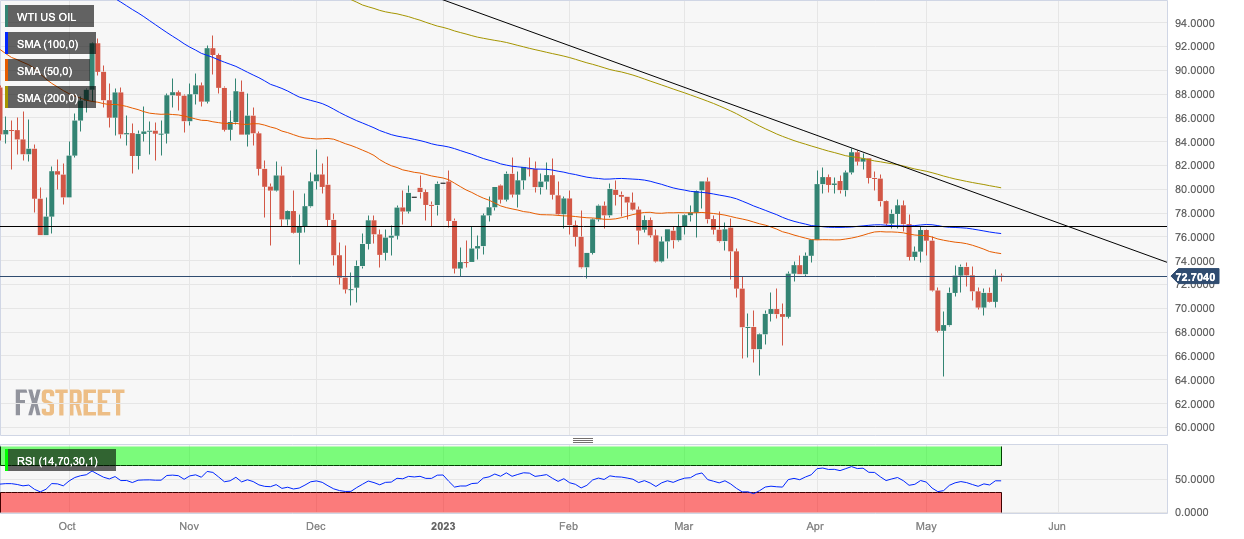- The price of oil trades with moderate losses, while the dollar is strengthened by the speeches of the Federal Reserve and the uncertainty about the US debt ceiling.
- Data showing a larger-than-expected build in inventories weighs heavily, but is offset by data showing rising global demand.
- Technically, the price of oil is in a downtrend, but a possible recovery is in sight.
The price of Petroleum fell on Thursday, around a fifth of a percentage point at the time of writing, after the US dollar, the currency in which oil is mainly quoted and traded, posted gains and data from the Information Administration de Energía (EIA) will show a higher than expected increase in inventories.
WTI Crude Oil is trading around $72.60 and Brent around $76.60 at the time of writing. Commodities are finding some support after data from the Joint Organizations Data Initiative (JODI) showed rising global demand for Oil in March on Thursday.
News on oil and markets
- EIA data on Crude Oil Stock Change (May 12) released late on Wednesday shows a 5.04 million barrel rise versus estimates for a 0.92 million barrel drop, indicating a strong offer and pushes down the price of Oil.
- The dollar rose, putting pressure on oil lower after Tuesday’s hawkish comments from Loretta Mester, President of the Cleveland Federal Reserve Bank. Mester upset expectations that the Fed would not need to raise rates further by saying that, given how stubborn inflation was, he could not ensure that the Fed funds rate would be at a level “where it is equally likely that the next move may be an increase or a decrease.”
- The uncertainty surrounding the US debt ceiling negotiations is beneficial for the dollar as a safe haven currency. Rising fears are therefore a support, as is optimism for a resolution, which would provide more indirect stimulus to the economy, raising US Treasury yields in the process, making further rate hikes more likely. and therefore supporting the USD.
- On Thursday, data from the Joint Organizational Data Initiative (JODI) showed rising global oil demand in March, putting a floor for oil price losses.
- The JODI report showed an increase in global demand of 3 million barrels per day (bpd) in March.
- Demand was especially strong in China, according to the Riyadh-based agency’s report, where total product demand increased by 1.6 million barrels per day (bpd) month-on-month, to 16.79 million bpd in March. This is the third largest increase in demand in the country.
- The United States also posted a month-on-month increase in total product demand of 1.77 million bpd, to a total of 21.77 million bpd, while, at the same time, US oil production fell by a quarter of a million bpd. .
Crude Oil Technical Analysis: The Downtrend Is Coming To An End
WTI oil is in a long-term downtrend, making lower lows. Keeping in mind the old adage that the trend is your friend, this favors short positions over long ones. It is trading below all the major daily simple moving averages (SMAs) and all the weekly SMAs except the 200-week SMA at $66.89.

US Crude Oil WTI: Daily Chart
However, a break below the year-to-date lows of $64.31 would be needed to reignite and reconfirm the downtrend, with the next target around $62.00 where the lows around 2021 will come into play as supports. archaic.
Despite the dominant downtrend, there are signs that it could be coming to an end. There is a slight bullish convergence between the price and the RSI at the March and May 2023 lows, with the price making a lower low in May that does not coincide with a lower low on the RSI. This is a sign that the bearish pressure is easing.
The long hammer candlestick pattern that formed at the May 4 (and year-to-date) lows is another sign that it may have been a key strategic bottom.
However, the bulls would have to break above the lower high of $76.85 on April 28 to cast doubt on the prevailing downtrend.
WTI Crude Oil Frequently Asked Questions
What is WTI oil?
WTI oil is a type of Crude Oil that is sold in international markets. WTI stands for West Texas Intermediate, one of the three main types, including Brent and Dubai crude. WTI is also known as “light” and “sweet” because of its relatively low gravity and sulfur content, respectively. It is considered a high quality oil that is easily refined. It is sourced in the United States and distributed through the Cushing hub, considered “the pipeline junction of the world.” It is a reference for the Oil market and the WTI price is frequently quoted in the media.
What factors determine the price of WTI oil?
Like all assets, supply and demand are the main factors that determine the price of WTI oil. As such, Global Growth can be a driver of increased demand and vice versa in the case of weak global growth. Political instability, wars and sanctions can alter supply and affect prices. The decisions of OPEC, a group of large oil-producing countries, is another key factor in prices. The value of the US dollar influences the price of WTI crude oil, as oil is mainly traded in US dollars, so a weaker dollar can make oil more affordable and vice versa.
How do inventories influence the price of WTI oil?
The weekly reports on oil inventories published by the American Petroleum Institute (API) and the Energy Information Agency (EIA) influence the price of WTI. Changes in inventories reflect the fluctuation of supply and demand. If the data shows a decline in inventories, it may indicate an increase in demand, which would drive up the price of oil. An increase in stocks may reflect an increase in supply, which lowers prices. The API report is released every Tuesday and the EIA report the following day. Their results are usually similar, with a 1% drop between them 75% of the time. The EIA data is considered more reliable, since it is a government agency.
How does OPEC influence the price of WTI oil?
OPEC (Organization of the Petroleum Exporting Countries) is a group of 13 oil-producing nations that collectively decide the production quotas of member countries in biannual meetings. Their decisions usually influence the prices of WTI Oil. When OPEC decides to cut quotas, it can restrict supply and drive up oil prices. When OPEC increases production, the opposite effect occurs. OPEC+ is an extended group that includes ten other non-OPEC member countries, among which Russia stands out.
Source: Fx Street
I am Joshua Winder, a senior-level journalist and editor at World Stock Market. I specialize in covering news related to the stock market and economic trends. With more than 8 years of experience in this field, I have become an expert in financial reporting.







